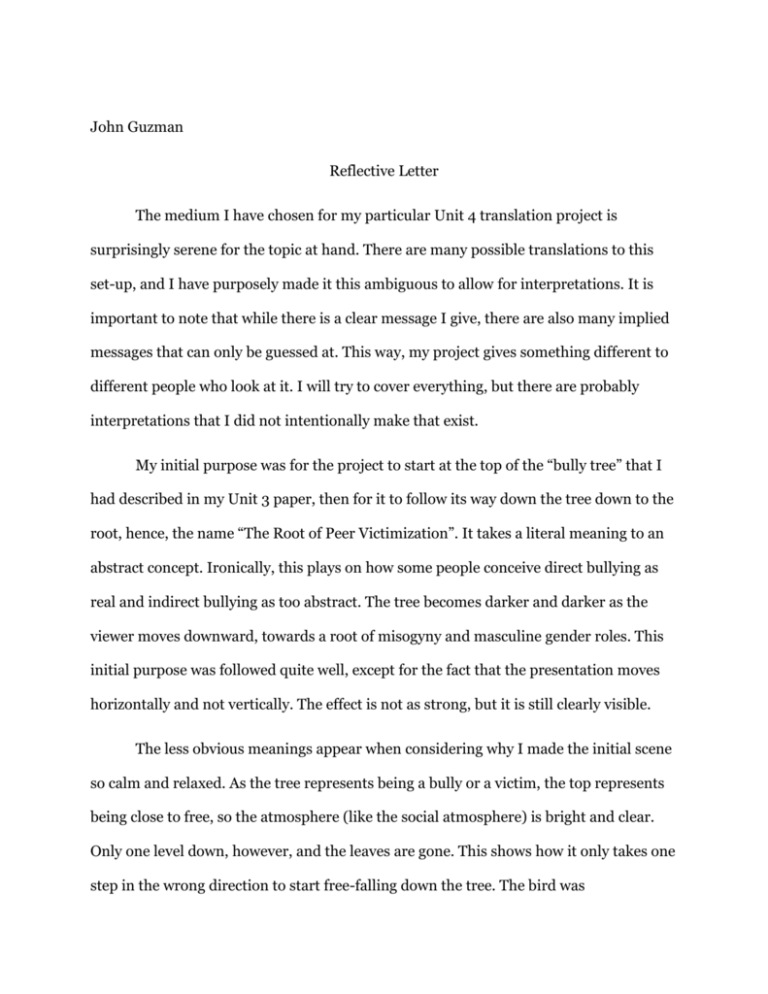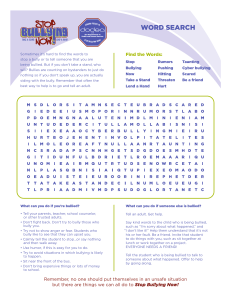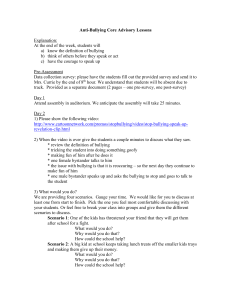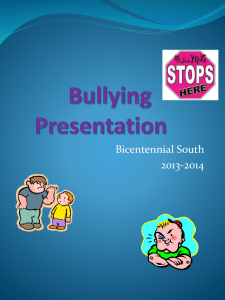Reflective Letter
advertisement

John Guzman Reflective Letter The medium I have chosen for my particular Unit 4 translation project is surprisingly serene for the topic at hand. There are many possible translations to this set-up, and I have purposely made it this ambiguous to allow for interpretations. It is important to note that while there is a clear message I give, there are also many implied messages that can only be guessed at. This way, my project gives something different to different people who look at it. I will try to cover everything, but there are probably interpretations that I did not intentionally make that exist. My initial purpose was for the project to start at the top of the “bully tree” that I had described in my Unit 3 paper, then for it to follow its way down the tree down to the root, hence, the name “The Root of Peer Victimization”. It takes a literal meaning to an abstract concept. Ironically, this plays on how some people conceive direct bullying as real and indirect bullying as too abstract. The tree becomes darker and darker as the viewer moves downward, towards a root of misogyny and masculine gender roles. This initial purpose was followed quite well, except for the fact that the presentation moves horizontally and not vertically. The effect is not as strong, but it is still clearly visible. The less obvious meanings appear when considering why I made the initial scene so calm and relaxed. As the tree represents being a bully or a victim, the top represents being close to free, so the atmosphere (like the social atmosphere) is bright and clear. Only one level down, however, and the leaves are gone. This shows how it only takes one step in the wrong direction to start free-falling down the tree. The bird was unintentional at first, but it fit perfectly when considering how above the tree, it was free, but just below the layer of thick leaves, it still had a chance, but it was too comfortable on its branch. In fact, that branch is the lowest one on the tree, even though viewers would initially expect many more. This is just like how bully victims who are new will only think that their problems are temporary instead of chronic, or bullies will think that they only need to overpower one individual to get what they want instead of many. The tree hole even lower down is a more comfortable, less accessible version of the branch; once you lie to yourself and believe that you can handle your situation, you get absorbed into this hole until you can identify your situation and act. The carved heart into the tree is self-explanatory – on first glance. By reading the accompanying material, one can see that child abuse and bullying don’t go together; they just add to a child’s misery. This heart-in-tree cliché is always applied to a happy couple that is young and returns to find it when they are older. Whether they are still in love or have moved on depends on the scenario, but it is always nostalgic to look at one. As the tree represents bullying, this cut-in heart can be seen by someone who carved their miseries into the tree later on in life, whether they have moved on or not. It is a symbol of the past, being retrospective of that which impacted you greatly when you were young. Another meaning is that couples are sometimes caught by another person reading their special love sign on the tree. The bully-misery tree, however, bears the scars of those trapped that deep on the tree and hopefully represents the fact that these victims are not alone. The bottom of the tree is so dark that nothing else can be seen. That is what being a bully or victim or so long can do to someone. Nothing outside seems relevant, nothing else is even visible. All that exists is this black mass of hate and sorrow. The white words gleam in the dark, moving towards hope in the darkness. Even lower, the root is revealed for exactly what it is, and below that, a new plant is born. This is the call to action-type conclusion that gives a satisfactory, closing statement to a dark and vague metaphor on peer victimization. This metaphor was built in the Unit 3 paper, and I kept referring to it so much that the paper should be renamed “Bully-Tree”. I believe that UNIV 200 showed where I excelled (crafting my argument once I had one) and where I need work (coming up with a workable, interesting topic in the first place). Also, the projects were engaging; the source abstracts made me actually use the sources, and the translation made me think visually artistically. UNIV has proved once again that it is not just an English course – it is a thinking course.











